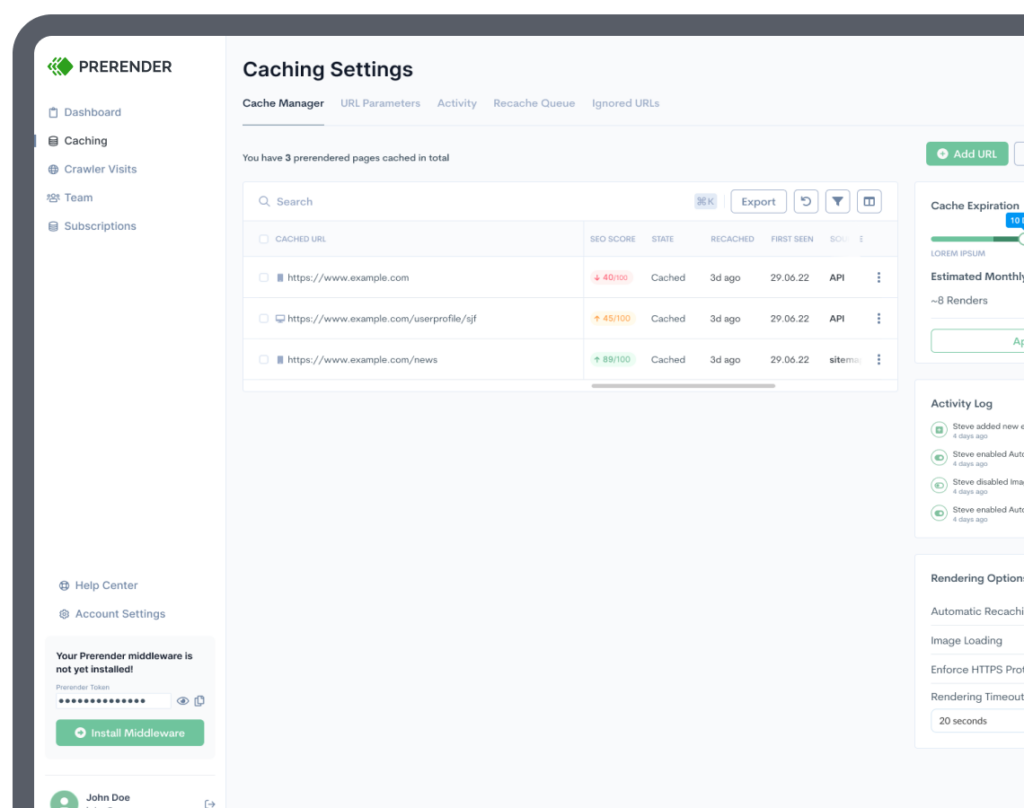VueJS SEO Optimization
Simplify SEO for your VueJS application with an easy prerendering solution that improves search visibility and crawling. Help your content get discovered faster and stay ahead of the competition.
Implement prerendering to serve fully rendered HTML to search engine bots, improving indexability and crawl efficiency for your VueJS app. Bypass client-side rendering limitations and deliver SEO-ready content without restructuring your codebase.
VueJS Explained
This front-end JavaScript framework is perfect for building fast, responsive web applications because of how easy to implement and lightweight it is.
For dynamic websites that offer interactive elements to enrich user experience (UX), install Prerender.io to increase crawling speed and search engine visibility.

VueJS Benefits
Vue.js works by encapsulating your content in JavaScript and connecting it to an HTML template. When a user interacts with your website or web application, Vue will only update those components instead of the entire page.
However, search engines can’t interact with your page as customers would.
When a search engine requests your page, they will only see a blank page. To access this dynamic content, search engines need to download your CSS, JavaScript, and all relevant files to render your page. This can make the crawling and indexing process 9X times longer than standard HTML websites.
Solving this problem can take months of engineering, expertise, and money. Or you can just use Prerender.io to get your pages crawled and indexed every time.
VueJS and Prerender
Although Vue is great for creating user-friendly functionalities, search engines like Google have difficulty handling JavaScript, while others don’t support it at all, leaving your web pages stagnant for weeks, months, or even indefinitely.
We solve this issue by fetching all your page’s files, including JavaScript, to generate a static HTML version and serve it to search engines. Our solution requires near-zero development time, and you’ll get all the benefits in days.
Unlike HTML pages, Google needs to download, compile, execute, and render your Vue code before finally being able to see your content. These extra steps affect indexation and ranking. Prerender.io speeds up the process by generating a fully rendered HTML version of your pages for search engines. Now, you can get your pages to feature in the SERPs as fast as just days after installing it.
Google crawls your site by following every link it finds on your pages, which is very simple on HTML pages but not on Vue.js sites. All your links are injected through JS, forcing Google to wait until your page is rendered before finding the next one. This results in wasted crawl budget and many undiscovered links.
Prerender.io ensures Google can discover every page fast by loading all your links alongside your content. This increases crawl speed and efficiency significantly.
Prerender.io caches your fully rendered pages and serves them directly to bots when needed.
In most cases, boosting your page speed to 90+ scores and getting Core Web Vitals (CWV) to near-perfect results.
“Prerender.io pushed Lighthouse metrics from around 40 to higher than 90, and stabilized the passing of the Core Web Vitals Assessment”
Review from Capterra

“With over 1 million pages within the US and another 500,000 in Canada, Prerender helps our sites get crawled faster, and helps with our visibility for potential clients on search engines. Choose Prerender.io to aid with issues rendering your web pages.”
Donald O’Connor
Technical SEO Analyst
When using Prerender.io, there are no complicated workarounds, expensive server costs, or long engineering time. Unlock the full potential of your Vue JS site. Get started with 1,000 URLs free.

All your Vue questions answered.
Just like other JavaScript frameworks, all sites built with VueJS are set, by default, to client-side rendering (CSR). Unfortunately, this means that Googlebot sees a blank page when it crawls, so there isn’t any content to index. Nowadays, Google is better at executing JavaScript, but it’s still an unreliable system that, more often than not, will penalize your website if you’re not using any solution to help your pages get crawled and indexed.
Dynamic rendering is associated with many positive outcomes that can help your site’s usability, SEO, and overall visibility.
All these benefits can be achieved using Prerender.io without the high price tag and complex implementation of server-side rendering or the drawbacks of still experimental workarounds.
Yes! Not only is Prerender.io a reliable solution that can help cut costs and save countless team hours, but it’s also incredibly simple to install. The process is completed in three main steps:
Serving +2.7 billion pages to crawlers.